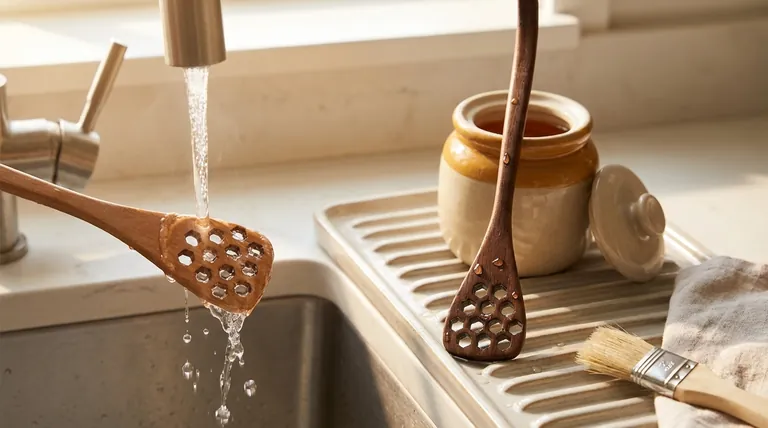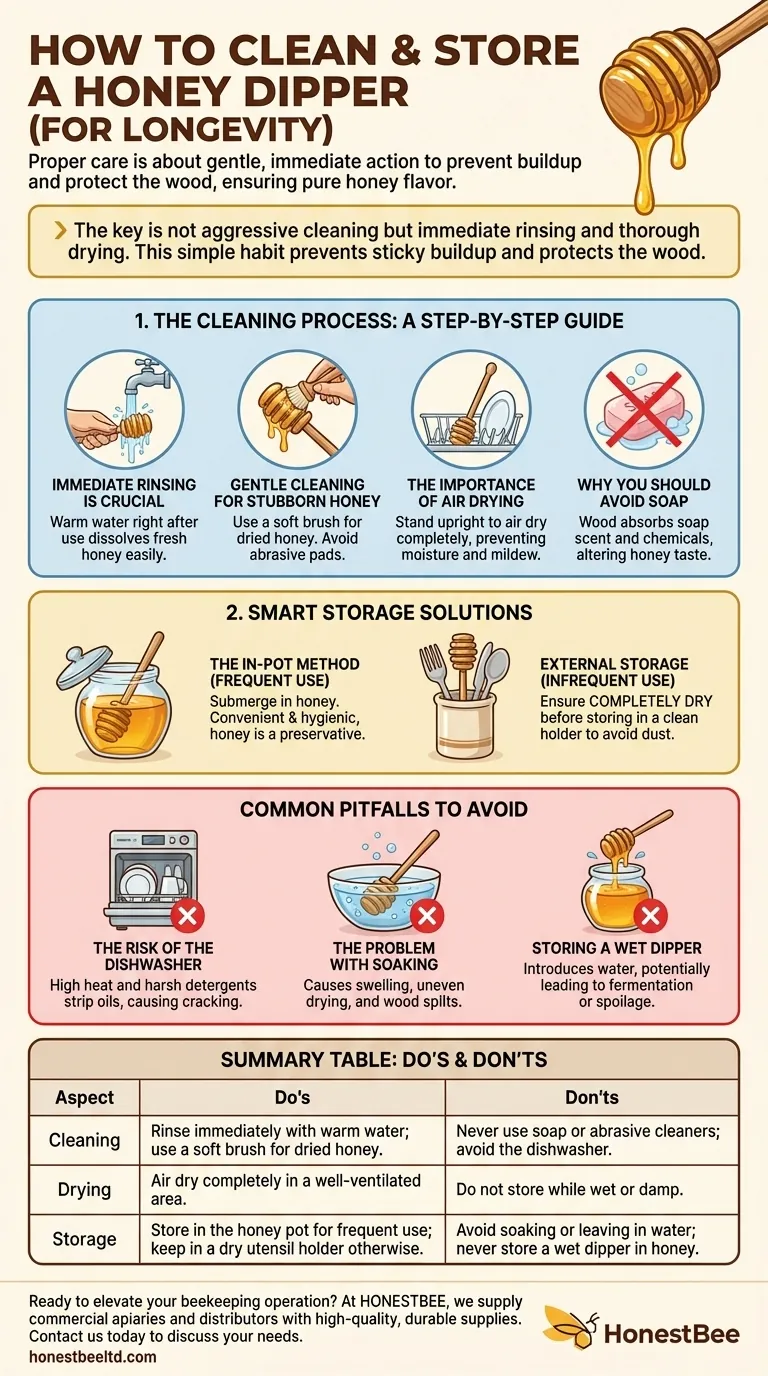To properly care for a honey dipper, you should rinse it under warm water immediately after use to dissolve any remaining honey before it hardens. Allow it to air dry completely before storing it, either inside your honey pot for convenience or in a dry utensil holder.
The key to maintaining a honey dipper is not aggressive cleaning but immediate rinsing and thorough drying. This simple habit prevents sticky buildup and protects the wood, ensuring the purity of your honey's flavor is never compromised.

The Cleaning Process: A Step-by-Step Guide
Proper cleaning is about gentle, immediate action. The goal is to remove the honey without damaging the dipper, especially if it is made of wood.
Immediate Rinsing is Crucial
Rinsing the dipper under warm water right after you use it is the most important step. Fresh honey dissolves easily, preventing it from crystallizing and hardening in the grooves, which makes it much more difficult to clean later.
Gentle Cleaning for Stubborn Honey
If some honey has already dried, use a small, soft brush to gently clean between the grooves. Avoid using abrasive pads or steel wool, as these can scratch and damage the surface of the wood.
The Importance of Air Drying
After rinsing, stand the dipper upright in a dish rack or utensil holder to air dry. This allows air to circulate around the entire tool, ensuring it dries completely and preventing moisture from getting trapped, which could lead to mildew or cracking.
Why You Should Avoid Soap
Wood is a porous material. Washing a wooden honey dipper with soap can cause it to absorb the soap's scent and chemical residue, which will then leach into your honey and alter its taste. Warm water is sufficient for cleaning.
Smart Storage Solutions
Where you store your dipper depends on how frequently you use it. Both primary methods are effective when done correctly.
The In-Pot Method: Convenience
For frequent users, the most practical solution is to store the dipper directly in the honey pot or jar. Honey is a natural preservative, so keeping the dipper submerged is perfectly hygienic and keeps it ready for instant use.
External Storage: Keeping it Dry
If you use honey less often, it is better to store the dipper externally. After cleaning and ensuring it is completely dry, place it in a utensil crock or a clean drawer. This prevents dust from collecting on a sticky dipper left out in the open.
Common Pitfalls to Avoid
Improper care can quickly ruin a wooden honey dipper. Avoiding these common mistakes is as important as the cleaning process itself.
The Risk of the Dishwasher
Never put a wooden honey dipper in the dishwasher. The combination of high heat and harsh detergents will strip the wood of its natural oils, causing it to dry out, warp, and crack.
The Problem with Soaking
Avoid the temptation to soak a dipper with hardened honey. Submerging wood in water for extended periods causes it to swell. As it dries, it will shrink unevenly, often leading to splits and cracks in the wood.
Storing a Wet Dipper
Never return a wet or even slightly damp dipper to your honey pot. Introducing water into honey can disrupt its natural balance and may lead to fermentation or spoilage over time.
Making the Right Choice for Your Goal
Your cleaning and storage routine should match your usage habits to ensure both convenience and longevity for your tool.
- If your primary focus is convenience: Store the dipper directly in your honey pot, as this keeps it primed and ready for frequent use.
- If your primary focus is long-term preservation: Clean and thoroughly air-dry the dipper after each use before storing it separately in a dry, ventilated utensil holder.
- If you use honey infrequently: Storing the dipper externally is the best practice to avoid potential crystallization or changes to the honey over time.
Ultimately, a simple routine of rinsing and drying is all that is needed to keep your honey dipper in excellent condition for years.
Summary Table:
| Aspect | Do's | Don'ts |
|---|---|---|
| Cleaning | Rinse immediately with warm water; use a soft brush for dried honey. | Never use soap or abrasive cleaners; avoid the dishwasher. |
| Drying | Air dry completely in a well-ventilated area. | Do not store while wet or damp. |
| Storage | Store in the honey pot for frequent use; keep in a dry utensil holder otherwise. | Avoid soaking or leaving in water; never store a wet dipper in honey. |
Ready to elevate your beekeeping operation? Properly maintaining your tools, like honey dippers, is just the start. At HONESTBEE, we supply commercial apiaries and beekeeping equipment distributors with high-quality, durable supplies designed for efficiency and longevity. From extraction tools to protective gear, our wholesale-focused offerings ensure your business runs smoothly. Contact us today to discuss your needs and discover how our products can support your success. Get in touch now!
Visual Guide

Related Products
- Modern Honeycomb Pattern Wooden Honey Dipper for Stirring and Drizzling
- Natural Wood Honey Dipper for Tea Coffee and Desserts
- Premium Heat-Resistant Glass Honey Dipper
- 0.5T Capacity Honey Dehumidifier Dryer with Vacuum Heating and Thickening Filtering Machine
- 10L Stainless Steel Electric Honey Press Machine
People Also Ask
- What is the impact of fermentation on honey? Understand the Science of Honey Spoilage
- How does high moisture content affect honey's curative properties? It Spoils Them Completely
- What is the role of enzymes in honey production? How Bees Transform Nectar into a Superfood
- What should a beekeeper do after extracting honey from supers? A Guide to Harvest Management
- What factors influence the water content of honey? Master Moisture Control for Stable Honey



















